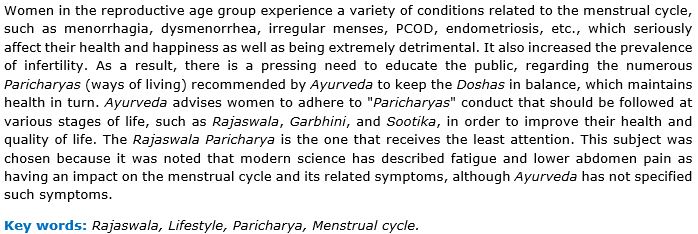A review on importance of Rajaswala Paricharya
DOI:
https://doi.org/10.21760/jaims.8.7.21Keywords:
Rajaswala, Lifestyle, Paricharya, Menstrual cycle.Abstract
Women in the reproductive age group experience a variety of conditions related to the menstrual cycle, such as menorrhagia, dysmenorrhea, irregular menses, PCOD, endometriosis, etc., which seriously affect their health and happiness as well as being extremely detrimental. It also increased the prevalence of infertility. As a result, there is a pressing need to educate the public, regarding the numerous Paricharyas (ways of living) recommended by Ayurveda to keep the Doshas in balance, which maintains health in turn. Ayurveda advises women to adhere to "Paricharyas" conduct that should be followed at various stages of life, such as Rajaswala, Garbhini, and Sootika, in order to improve their health and quality of life. The Rajaswala Paricharya is the one that receives the least attention. This subject was chosen because it was noted that modern science has described fatigue and lower abdomen pain as having an impact on the menstrual cycle and its related symptoms, although Ayurveda has not specified such symptoms.
Downloads
References
Charakacharya, Charak Samhita, with Hindi commentary by Pt.Kashinatha Sastri and Dr. Gorakha Natha Chaturvedi; Chaukhambha Bharati Academy; Chikitsa Sthana, Chapter no.30,Verse no.225.
Astanga Hridayam of Srimad Vagbhata, edited with Nirmala Hindi Commentary by Dr. Brahmanand Tripathi, Chaukhamba Sanskrit Pratishthan, Sharir Sthana, Chapter no.1, verse no.7
Charakacharya, Charak Samhita, with hindi commentary by Pt.Kashinatha Sastri and Dr. Gorakha Natha Chaturvedi; Chaukhambha Bharati Academy; Sharir Sthana, Chapter no.8,Verse no.5.
Acharya Sushruta, Sushruta Samhita, hindi commentary by Kaviraja Ambikadutta Shastri; Chaukhambha Sanskrit Sansthan; Sharir Sthana, Chapter no.2-verse no.26.
Acharya Sushruta, Sushruta Samhita, hindi commentary by Kaviraja Ambikadutta Shastri; Chaukhambha Sanskrit Sansthan; Sharir Sthana, Chapter no.2-verse no.27
Premvati Tiwari, Ayurvediya Prasuti Tantra Evum Stree Roga, second edition, Chaukhambha Orientalia.
Astanga Samgraha of Vagbhata, translated by Prof. K. R. Srikantha Murthy, Chaukhambha Orientalia, Sutra sthana, Chapter no.26, verse no.32.
Astanga Hridayam of Srimad Vagbhata, edited with Nirmala Hindi Commentary by Dr. Brahmanand Tripathi, Chaukhamba Sanskrit Pratishthan, Sutra Sthana, Chapter no.17, verse no.24.
Kashyap Samhita, edited by Sree Satyapal Vishagacharya, Chaukhamba Samskrit Samsthan, Siddhi Sthana, Chapter no.4, verse no.5
Sushrura Samhita, edited by Kaviraj Ambikadutta Shastri, Chaukhambha Sanskrit Sansthan, Sharir Sthana, Chapter no.2, verse no.27
Sushrura Samhita, edited by Kaviraj Ambikadutta Shastri, Chaukhambha Sanskrit Sansthan, Sharir Sthana, Chapter no.2, verse no.26















